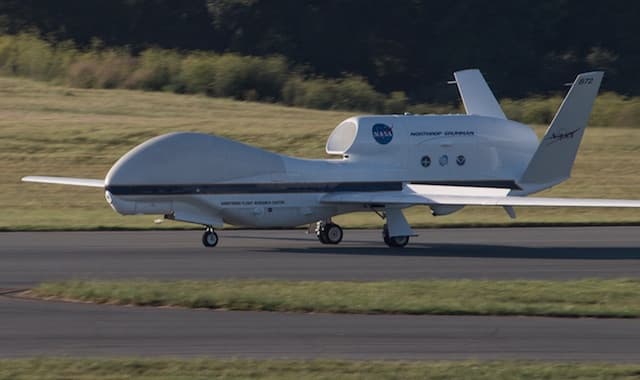NASA's Global Hawk Aircraft Will Help Improve Hurricane Tracking And Intensity Forecasts
NASA's <a href="https://www.nasa.gov/centers/armstrong/aircraft/GlobalHawk/index.html" target="_blank" rel="noopener noreferrer">Global Hawk | NASA</a> is a remotely piloted aircraft is on a new mission to support National Oceanic and Atmospheric Administration's (#-Link-Snipped-#) mission to improve the overall tracking of hurricanes and forecast their intensity. The Global Hawk is completely operated by the ground crew located at NASA's Wallops Flight Facility and its new mission will be called SHOUT, which stands for Sensing Hazards with Operational Unmanned Technology. This mission will be an extension of earlier collaborative missions taken up by NASA to use Global Hawk aircraft as a weather forecasting tool.
The Global Hawk will fly above hurricanes and other storms, at an altitude of about 60,000 ft, to collect important data about weather patterns. The aircraft has been engineered to keep recording data continuously for about 24 hours and help scientists figure out how powerful and intense these storms or hurricanes are. This information will allow the authorities to take necessary actions to improve nation's preparedness to face the storm.

Photo Credit: NASA
One of the biggest advantage of Global Hawk is that it can stay over hurricanes and storm for a longer period of time over manned aircrafts. The Global Hawk can thus act as observation tool that has the endurance of a satellite and collect data with far better resolution and precision.
The Global Hawk will be equipped with lot of sensing instruments that will help determine the profile of the storms. These include temperature sensors, wind-speed measurement, direction and pressure sensors along with HIWRAP (High Altitude Imaging Wind and Rain), HAMSR (High Altitude MMIC Sounding Radiometer) and LIP (Lightening Instrument Package).
In the next trial, the team of scientists will check whether the data obtained from Global Hawk can act as a substitute for the data collected by weather satellites. Read further details about the new mission on the source link below.
Source: <a href="https://www.nasa.gov/centers/armstrong/features/shout_mission_begins.html" target="_blank" rel="noopener noreferrer">NASA Remotely Piloted Aircraft to Begin NOAA Hurricane Mission | NASA</a>
The Global Hawk will fly above hurricanes and other storms, at an altitude of about 60,000 ft, to collect important data about weather patterns. The aircraft has been engineered to keep recording data continuously for about 24 hours and help scientists figure out how powerful and intense these storms or hurricanes are. This information will allow the authorities to take necessary actions to improve nation's preparedness to face the storm.
Photo Credit: NASA
One of the biggest advantage of Global Hawk is that it can stay over hurricanes and storm for a longer period of time over manned aircrafts. The Global Hawk can thus act as observation tool that has the endurance of a satellite and collect data with far better resolution and precision.
The Global Hawk will be equipped with lot of sensing instruments that will help determine the profile of the storms. These include temperature sensors, wind-speed measurement, direction and pressure sensors along with HIWRAP (High Altitude Imaging Wind and Rain), HAMSR (High Altitude MMIC Sounding Radiometer) and LIP (Lightening Instrument Package).
In the next trial, the team of scientists will check whether the data obtained from Global Hawk can act as a substitute for the data collected by weather satellites. Read further details about the new mission on the source link below.
Source: <a href="https://www.nasa.gov/centers/armstrong/features/shout_mission_begins.html" target="_blank" rel="noopener noreferrer">NASA Remotely Piloted Aircraft to Begin NOAA Hurricane Mission | NASA</a>
0
